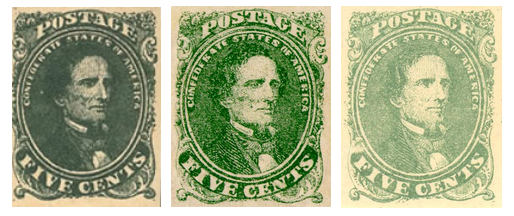
Left: CSA 1-AB, Stone AB, Middle: CSA 1-1, Stone 1, Right: CSA 1-2, Stone 2
Catalog Numbers are from the Confederate States of America Catalog and Handbook of Stamps and Postal History
The stamp's central motif is a portrait of Confederate President Jefferson Davis, designed and engraved on metal by Charles Ludwig of Hoyer & Ludwig, Richmond, Virginia. There is a wide range of shades of green among the issued stamps, which help distinguish the various printings of this first issue. There were 9,250,000 stamps printed from three different lithographic stones. They were printed on soft, porous, wove paper, and were imperforate. The most typical use is for the 5-cent rate (under 500 miles), although pairs are known used for the 10-cent rate (over 500 miles), and occasionally used for higher rates, which are very scarce. Stones can be identified only by plating and not by clarity of printing or color shade.
Stone A or B: The designation Stone AB is attributed to Edward S. Knapp, who in the 1920s was uncertain if there was one or two transfer or printing stones.The earliest recorded date of use is October 16, 1861, also the first day of any Confederate general issue as noted in the Richmond Daily Examiner of that date. Plating is not completed, therefore size of the plate is unknown. These stones had imprints. Printings from this stone are characterized by their uniform olive green color and the best quality of the three stones with sharp clear impressions. There are no minor colors. Distinctive marks are few and minute.
Stone 1: The earliest established recorded date of use is October 23, 1861. Plating is completed. The stamps were printed in sheets of two hundred, panes of one hundred, and a transfer stone of fifty without imprint. A number of constant, recurring varieties occur on the fifty-subject transfer stones. The first small printing was in olive green, with other shades of bright green, dark green, light green, and dull green. The typical shade is an intermediate shade of bright green. Impressions are clear, although not a clear as on Stones AB. Stamps from Stone 1 have a lighter or finer printed impression than those from Stone AB or Stone 2.
Stone 2: The earliest recorded date of use is December 2, 1861. The stamps were printed in sheets of two hundred, panes of one hundred, and a transfer stone of fifty without imprint. All shades other than olive green are known from this stone, primarily darker shades. It is characterized by poor impressions and many noticeable distinctive marks. This stone was also used to print the 5-cent blue Jefferson Davis, CSA 4, of the same design but different color.
Misplaced and Shifted Lithograph Transfers: A misplaced transfer is an image that is on a printing stone in a position that differs from that on the transfer stone. The misplaced transfers were first discovered in the 1920s by Edward S. Knapp and others. They were originally thought to be damaged positions that had been erased and replaced on the printing stones that were in stamp production. Although this is a viable explanation, it now appears that they were on new printing stones and were corrections made when the printing stones were initially laid down. This is a complex topic too detailed to even touch on in a general guide. For more information, see the Confederate States of America Catalog and Handbook of Stamps and Postal History.
1862 Color Changes
The 1862 color changes from green (CSA 1) to blue (CSA 4) were explained by a notice in Southerrn newspapers on February 20, 1862, by the Confederate Post Office Department: "We perceive that in consequence of a scarcity of coloring necessary for the manufacture of green postage stamps, of the denomination of five cents, stamps of a blue color will be substituted for the latter. The ten ct. stamps will hereafter be red." They continued to print the 2¢ Jackson (CSA 3) in green because the demand was much lower.